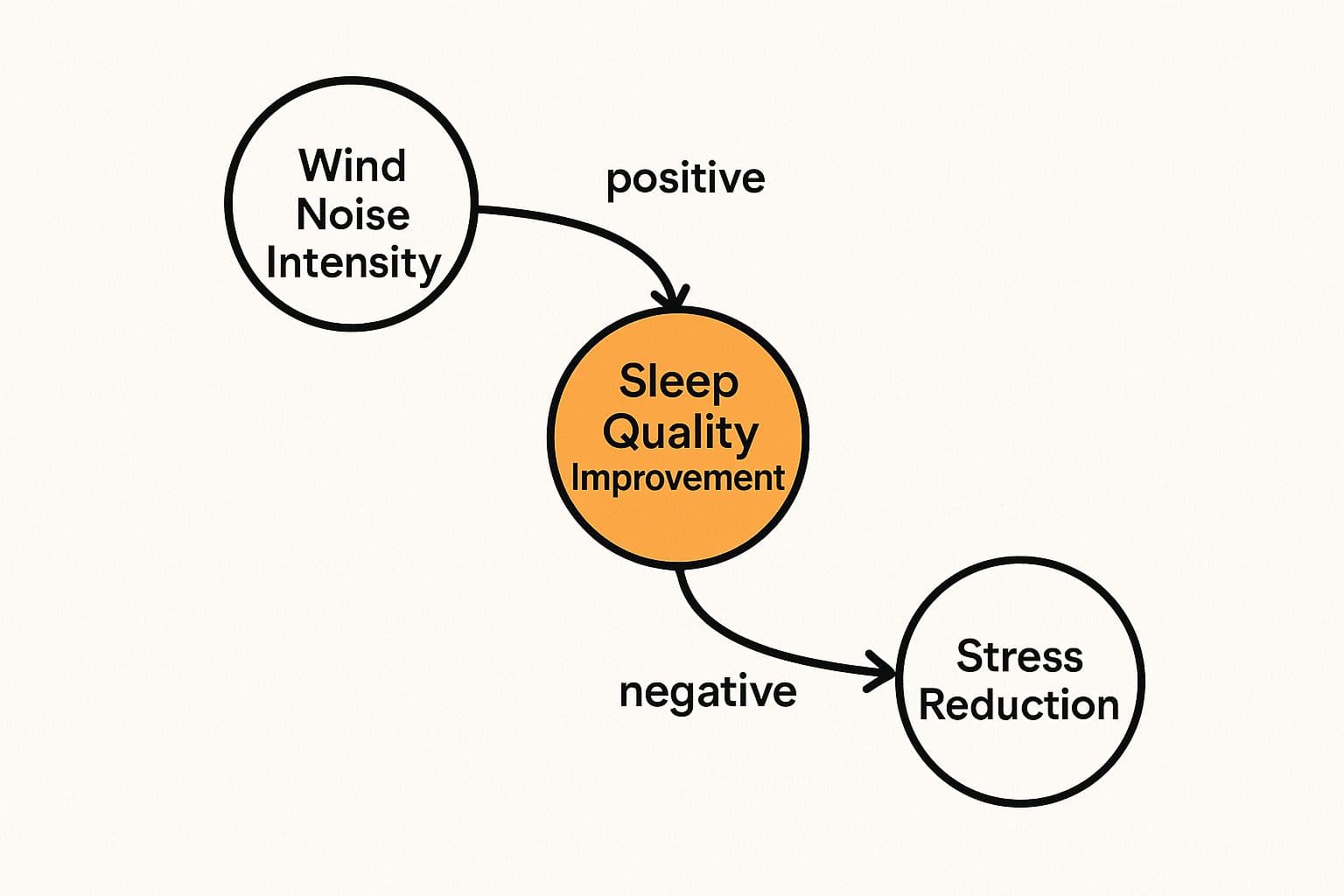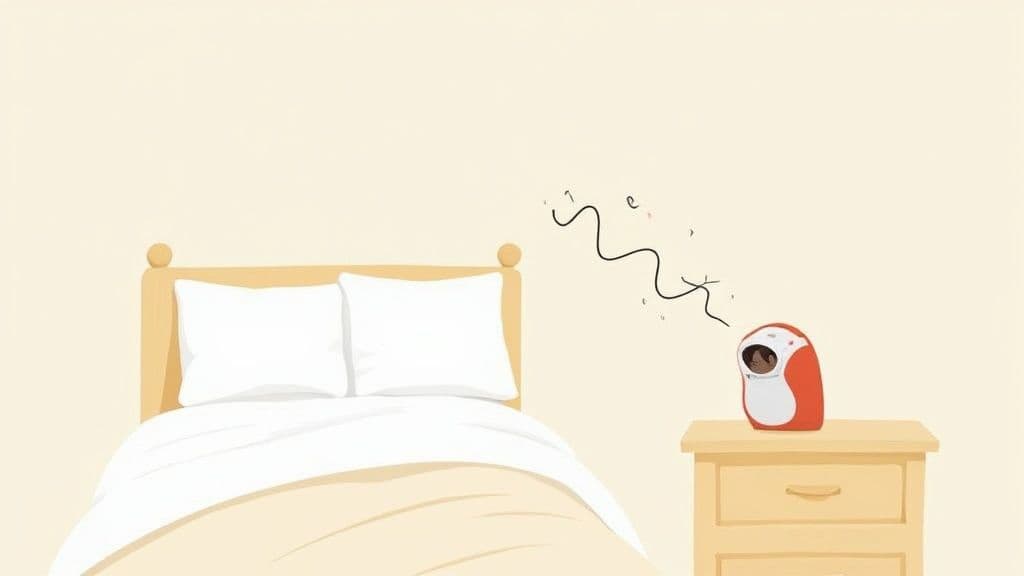Unlocking Deeper Rest with Wind Noise for Sleep
Discover how wind noise for sleep can transform your nights. This guide explores the science, benefits, and best methods to achieve deeper, more restful sleep.
Struggling to switch off at night? If you find yourself staring at the ceiling, you’re not alone. Many people are now turning to wind noise for sleep, and for a very good reason. Think of it as a protective ‘sound blanket’ that wraps your senses in a steady, calming audio texture, making it an incredibly effective tool for quieting a busy mind.
Why Wind Sounds Help You Fall Asleep Faster

The real magic of wind sounds is their consistency. Our brains are hardwired to notice sudden changes in our surroundings—a survival instinct that once kept our ancestors safe from predators. In our modern world, that instinct is triggered by a sudden car horn, a neighbour's slamming door, or even a snoring partner, jolting you right out of that precious pre-sleep state.
Consistent wind noise for sleep creates a stable auditory backdrop. This gentle, persistent sound effectively raises the overall noise level in your room, so those unexpected, jarring sounds become far less noticeable. Instead of being startled awake, your brain registers them as insignificant blips against the much larger canvas of the wind.
The Soothing Nature of Natural Sounds
But it’s more than just masking noise. The actual character of wind is inherently calming. Unlike the sharp, static-like hiss of pure white noise, most natural wind sounds are a form of pink noise. Pink noise has more power in the lower frequencies, which our ears perceive as deeper and less harsh.
Think about the difference between a shrill, high-pitched fire alarm and the deep, low rumble of distant thunder. That lower-frequency sound feels more comforting and less alarming, which is exactly what you want when you’re trying to relax.
This quality helps create an immersive environment that encourages your mind to let go of the day's stresses. The gentle, flowing sound of a breeze rustling through trees or sweeping across an open field doesn’t demand your attention. Instead, it offers a simple, peaceful focal point that helps silence that relentless internal chatter.
By combining powerful sound masking with this naturally soothing quality, wind noise becomes a fantastic dual-action sleep aid. It simultaneously blocks out external disturbances and calms your internal state, setting the stage for a night of deep, restorative rest.
The Science Behind Sound Masking and Sleep

To really get why wind noise works so well for sleep, try to picture your sleeping brain as a hyper-sensitive microphone. It’s always on, listening for potential threats. A sudden, sharp sound—like a car door slamming or a dog barking down the street—can easily trip its alarm and jolt you right out of your rest.
This is where a consistent sound like wind comes in. It works by gently raising the baseline level of sound in your room, creating what’s known as a sound mask. Think of it as a sort of “sound blanket” that covers you. This auditory blanket doesn't actually eliminate other noises, but it dramatically shrinks the gap between background silence and a sudden disruption.
A whisper in a quiet library is incredibly jarring. But that same whisper in a bustling coffee shop? You wouldn't even notice it. Wind noise is your personal coffee shop, making those abrupt sounds far less likely to startle you awake.
Pink Noise: The Soothing Sibling of White Noise
But here’s something you might not know: not all background sound is created equal. Many of the natural wind sounds we find so calming are a form of pink noise, which is quite different from its more famous cousin, white noise.
While white noise hits all sound frequencies with the same intensity (think of old TV static), pink noise has more power in its lower, deeper frequencies. This gives wind that deep, rumbling quality that most people find far more soothing and less harsh than the high-pitched hiss of pure white noise. That rich sound profile is what creates a truly immersive and calming environment, perfect for lulling you to sleep.
Of course, the type of wind sound is crucial. Not all of it is helpful. For example, the unique, pulsating thrum of wind turbines can actually be quite disruptive. A 2021 study found that people living near wind farms often reported more sleep issues, which just goes to show how important the character of the sound is for rest. You can read more about how certain noises disrupt sleep in this detailed report.
Finding a high-quality, natural sound is everything, which is why choosing the right source matters. If you're exploring your options, our guide on what is the best free sleep sound app can help you find your perfect match.
How to Choose the Right Wind Sound for You
Let's be honest, not all wind sounds are created equal. Finding the right kind of wind noise for sleep is a lot like picking the perfect lighting for a room—the character and intensity can completely change the vibe. Your perfect match really comes down to what you like and, more importantly, what specific noises you’re trying to drown out.
Think of it this way: some nights, you might need to block out a piercing siren from a passing ambulance. Other nights, it’s the low, thumping bass from a neighbor's party that’s keeping you awake. The world of wind audio offers a whole palette of sounds to tackle these different challenges, from the soft rustle of a breeze through pine trees to the steady, deep hum of a high-altitude jet stream.
This infographic breaks down the relationship between the intensity of wind noise, how much it can help your sleep, and its effect on stress.

As you can see, getting the intensity right is a balancing act. The right sound boosts sleep quality, which in turn helps melt away stress.
Matching the Sound to Your Sleep Needs
So, how do you find your perfect soundscape? Start by thinking about what you're trying to achieve. Are you dealing with the unpredictable chaos of city life and need something dynamic and roaring? Or are you just looking for a soft, consistent whisper to gently quiet your mind?
A coastal gale, for example, with its rich, low-frequency roar, is fantastic for masking deep rumbles like traffic or construction noise. On the flip side, a light breeze whispering through leaves has those higher-frequency notes that are great at covering up sharper sounds, like distant chatter or the first birds chirping at dawn.
Comparing Different Types of Wind Sounds for Sleep
To help you decide, think about the unique "personality" of each wind sound. Some are deep and steady, while others are light and variable. This table breaks down a few common types to get you started.
Type of Wind Sound | Sound Profile | Best For Masking | Potential Vibe |
Gentle Breeze | Light, high-frequency rustling, occasional soft gusts. | Distant chatter, tinnitus, chirping birds. | Calm, peaceful, like a lazy summer afternoon. |
Forest Wind | A mix of rustling leaves and deeper, airy tones. | General household noises, light snoring. | Grounding, natural, like a walk in the woods. |
Coastal Gale | Deep, powerful, low-frequency roar with dynamic gusts. | Loud traffic, construction, booming bass. | Powerful, immersive, a dramatic seaside escape. |
Mountain Pass Wind | A steady, high-altitude whistle or hum; consistent. | High-pitched electronic hums, sirens. | Isolating, stark, a sense of vast, open space. |
Ultimately, the best way to find what works is to simply try them out. Experimentation is your best friend here.
Many apps and sound machines, including the sound mixer right here on Otherworld Tales, let you sample various wind types. Play around with a few different options. See which one not only blocks out the disruptions you're dealing with but also feels genuinely soothing to you. It's this hands-on approach that will lead you to the perfect sound for your sleep sanctuary.
So, Are There Any Downsides to Wind Noise?

While the right kind of wind noise can be a fantastic sleep aid, it’s crucial to understand that not all wind sounds are created equal. There's a world of difference between a gentle, natural breeze rustling through leaves and the unwanted drone of industrial machinery.
The character of the sound matters just as much as its volume. Think of it like music. A soft classical piece can lull you into a state of calm, but a blaring rock anthem at the exact same decibel level would have the opposite effect. The same idea applies here—you need a sound your brain registers as soothing, not as an alert or an annoyance.
This is especially true for man-made wind noises. The sounds coming from something like a wind turbine, for example, have very specific acoustic properties that can be more disruptive than restful.
When Wind Turns into a Nuisance
The low-frequency, pulsing whoosh of wind turbines is a perfect example of a sound that just doesn’t work for sleep. For many people, this rhythmic thumping never quite fades into the background. Instead, it becomes a persistent, almost nagging presence that makes it incredibly difficult to relax, let alone fall asleep.
And this isn't just about personal taste; it's a well-documented issue. A 2023 meta-analysis that looked at 15 different studies found a clear link between living near wind turbines and experiencing sleep problems.
The analysis discovered that the overall prevalence of sleep disorders among residents near wind turbines is roughly 34%. It also showed a distinct pattern: the farther people lived from the turbines, the better they slept. You can see the full meta-regression analysis findings here.
This research gets to the heart of the matter. Using wind noise for sleep is only effective if you choose the right kind of wind. The goal is to find a sound profile that’s steady, natural, and free from the jarring, repetitive patterns that can put your nervous system on high alert. Once you understand that the quality of the sound is key, you can pick a soundscape that truly helps you rest.
Simple Steps to Use Wind Noise Effectively
Bringing wind noise for sleep into your nightly routine is pretty simple, but a few small tweaks can make a massive difference. The real goal here is to create a steady, soothing backdrop that tells your brain, "Okay, it's time to switch off."
First, you need to find that perfect volume. Think of it like a balancing act. The sound should be just loud enough to drown out sudden noises—a car alarm, a barking dog—but not so loud that it becomes a new distraction. A good starting point is to set it at a level that feels like a quiet conversation in the background.
Best Practices for Your Soundscape
Once you've got the volume dialled in, think about how long you want it to play. Some people love having the wind going all night long. Others, however, find it works best with a sleep timer. You could try setting the sound to fade out gently after 30-60 minutes, which is often just enough to help you drift off without becoming dependent on it to stay asleep.
Here are a few more tips to get the most out of your wind-filled nights:
Choose Your Source Wisely: You can go with a dedicated sound machine or a good smartphone app. Sound machines are wonderfully straightforward, but apps often give you more control and variety—like the sound mixer we built right here at Otherworld Tales.
Consistency is Key: Try to use your chosen sound every single night. This repetition creates a powerful sleep trigger, training your brain to relax the moment it hears that familiar, gentle gust.
Create a Sleep Sanctuary: Wind noise is a fantastic tool, but it works even better when it’s part of a bigger picture. Make sure your bedroom is dark, cool, and comfortable to create a powerful synergy for rest.
By combining a calming soundscape with a proper sleep environment, you're not just masking noise; you're actively building a robust foundation for deeper, more restorative rest.
Ultimately, using wind noise is about creating a predictable and peaceful end to your day. It’s a simple yet surprisingly effective tool that can dramatically improve the quality of your sleep when you get it right. For more ideas on how to get the most out of every minute of rest, you might find our guide on how to sleep for 5 hours and still feel rested helpful.
Frequently Asked Questions About Using Wind Sounds
As you start experimenting with wind noise for sleep, you'll probably have a few questions. It’s completely natural. Getting good answers helps you build the perfect routine, making sure you get all the benefits without any of the guesswork.
Let's walk through some of the most common queries. We'll give you clear, straightforward answers so you can feel confident and get the most out of your new sleep ritual.
Is It Bad to Sleep with Wind Noise All Night?
For most people, it's perfectly safe to let low-volume wind sounds play all night long. In fact, keeping it on can be a huge help, creating a steady sonic blanket that masks those sudden noises—like a car door slamming or a dog barking—that might otherwise wake you up.
That said, some sleep experts recommend using a sleep timer to fade the sound out once you’ve drifted off. The idea is to avoid becoming too dependent on it. The most important thing, no matter what, is to keep the volume at a safe, conversational level.
What Is the Difference Between Wind Noise and White Noise?
You’ve probably heard of white noise—that static-like "hiss" you get from a detuned radio. It contains all sound frequencies playing at the same intensity. Wind noise, on the other hand, is a whole different beast. Most natural wind sounds are closer to pink or brown noise, which have more depth and richness in the lower frequencies.
This difference is key. The deep, rumbling quality of wind often feels far more organic and soothing than the sometimes-harsh edge of pure white noise. It’s why so many people find it a more comforting and popular choice for relaxation.
Can Wind Noise Help with Tinnitus?
Yes, absolutely. Many people discover that wind sounds are a fantastic tool for managing tinnitus, especially when trying to fall asleep. This approach, often called sound therapy, works by giving your brain a pleasant, external sound to latch onto.
Instead of focusing on the internal ringing or buzzing, your mind is drawn to the gentle, shifting tones of the wind. This can make the tinnitus seem quieter and less intrusive, making it much easier to relax and drift off. If you also struggle with a busy mind at bedtime, you might find our calming stories for anxiety offer another welcome layer of mental peace.
Should I Use Headphones or a Speaker?
For all-night listening, a speaker is almost always the better and safer option. Trying to sleep with headphones or earbuds can get uncomfortable pretty quickly, and over time, it can even lead to things like ear irritation or wax buildup.
A good speaker placed a few feet away from your bed can fill the room with sound more naturally. It creates a truly immersive atmosphere without you needing to wear anything, letting you sleep in total comfort.
Ready to find your perfect sleep soundscape? Otherworld Tales combines enchanting bedtime stories with a customizable sound mixer, allowing you to blend the perfect wind noise for sleep with a captivating narrative. Discover your ideal mix and drift off into a world of peaceful dreams tonight at https://www.otherworldtales.com.